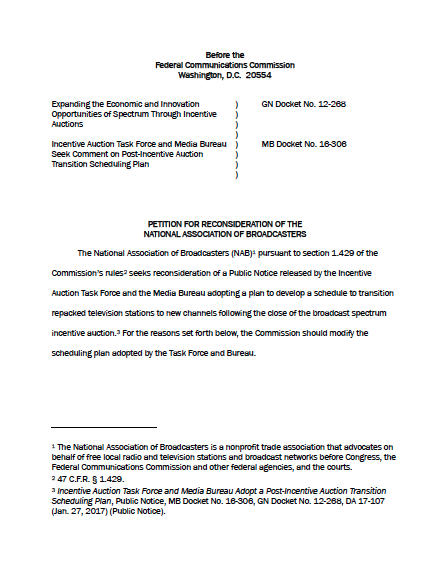NAB Seeks Repack Reconsideration

WASHINGTON—The broadcast team wants a do-over of the TV channel repack plan created by the Federal Communications Commission for the post-TV spectrum incentive auction signal shuffle. The National Association of Broadcasters filed for a Petition of Reconsideration on the FCC’s repack plan, issued in a Jan. 27, 2017 Public Notice. The plan is for broadcasters get off their pre-incentive auction channel assignment within 39 months, no ifs, ands or buts. The NAB and others in the broadcasting community have long held this 39-month window is insufficient to move as many as 1,274 full-power and Class A TV stations[1]—notwithstanding as many as 3,150 low-power TV and translator licensees[2]—into the 16 remaining TV channels. The NAB stayed the course in its March 17, 2017 petition:
“The commission has not previously resolved critical matters with respect to how best to organize this complex transition, and the Public Notice, which is predicated on perpetuating the fiction that compliance with the arbitrary 39-month deadline is possible, reflects a commission policy that should be promptly revised.”
The FCCs’ post-incentive auction scenario is roughly as follows. The current and final phase of the auction, where wireless bidders jockey for specific frequencies, will close March 30. In April, the commission will issue an “Auction Closing and Channel Reassignment Public Notice,” in which new channel assignment are published. Stations, however, should already be apprised of their own assignments via confidential letters that went out a few weeks ago.
The channel reassignment PN triggers a couple of things—a 90-day deadline to apply for construction and/or modification permits. In other words, engineers for thousands of TV stations will have to anticipate both the signal and coverage characteristics of a new channel as well as every last resource to make it work.
After the 90-day permit window closes, a testing phase will begin when broadcasters can test gear on new channel assignments. Then the repack will commence regionally in 10 phases according to various factors, most of which boil down to the limited number of tower crews with the skill and equipment to tackle tall steel. (See sidebar, “The Phase Scheduling Tool,” Oct. 5, 2016.)
Then 39 months in, ready or not, broadcasters must stop transmittingon pre-auction channels. That’s when the wireless carriers, who purchased nearly half of the remaining airwaves designated for local U.S. TV operations for $19.6 billion, will begin taking over UHF Channels 38-50.
In its petition, the NAB said the FCC’s repack modeling relied on “imprecise proxies and inputs,” and that the deadline is being put in place “months before the FCC has any meaningful real-world information about the work that will actually be required to move any individual station.” It also said the FCC plan does not take into account delays due to things like municipal zoning or acts of nature, including harsh winter weather.
The NAB said the commission’s repack plan places the 39-month deadline above all other considerations, and that viewers and FM listeners will pay for any repack faux pas by losing coverage of stations that can’t make the move within the prescribed timeframe. Many FM radio operations share towers with TV broadcasters, which the NAB said the FCC’s plan should take into consideration. The Corporation for Public Broadcasting has said at least 191 public radio stations will be affected.
The NAB said the commission should instead grant “reasonable requests for extensions of time.” The digital TV transition took 10 years, it noted. The 800 MHz reconfiguration was supposed to be done in three years and continues eight years past that timeframe.
“There is no reason to assume the commission’s ability to bend reality to its deadlines has improved over time,” the petition said.
The NAB further urged the commission to delay assigning stations to moving phases until structural and engineering studies are done.
“Assigning stations to repacking phases and assigning deadlines for those phases before the stations themselves know what work will be required is the opposite of a process tailored to stations’ individual circumstances,” the NAB said.
The NAB petition also called on the FCC to have its Media Bureaumanage the repack, and have personnel in the field gathering and sharing information on the unforeseen complexities. Currently, the commission has authorized periodic reporting from affected stations. The petition also said the wiggle room left in the FCC plan for international coordination with Canada and Mexico is “unacceptable” in that the FCC should have figured it out before assigning channels.
“Repacked stations along the border deserve to know now whether or not their channel assignments will require coordination,” the petition stated.
[1] “Transition Scheduling Plan Webinar,” Oct. 17, 2016, p. 34.
[2] Presentation to FCC commissioners and staff by LPTV Spectrum Rights Coalition, Feb. 28, 2017.
For moreTV Technology coverage, see our spectrum auction silo.
Also see...
Jan. 27, 2017
“Post-Auction: 39 Months or Bust”
There’s no avoiding a deadline.
Jan 27, 2017
“NAB Asks for Repack Reporting Tweaks”
Yes or no does not always the question answer, the National Association of Broadcasters told the folks at the Federal Communications Commission regarding a proposed form for periodic channel-repacking reports.
Jan. 10, 2017
“FCC Seeks Feedback on Repack Reporting Process”
Stations eligible for reimbursement comprise all full-power and some Class A stations involuntarily assigned to a new channel. The PN said a “small number of Class A stations are not protected during the repacking process, and if displaced as a result of repacking will not be eligible for reimbursement.”
Oct. 5, 2016
“FCC Repack Plan: Key Points”
Get the TV Tech Newsletter
The professional video industry's #1 source for news, trends and product and tech information. Sign up below.
